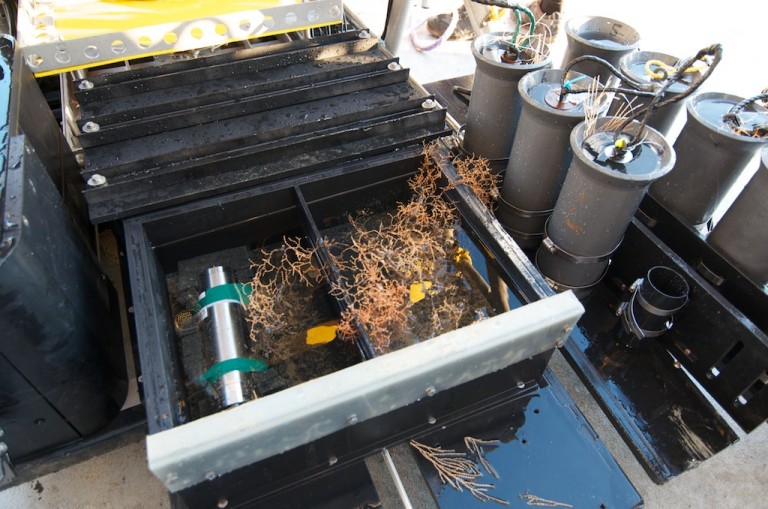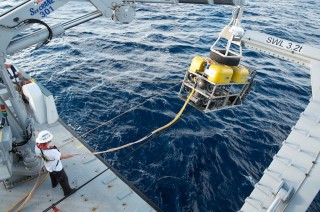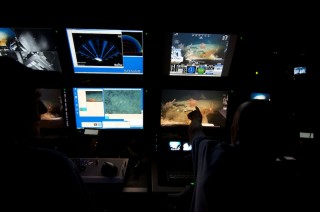The research team onboard was very excited to begin scientific underwater surveys and sample collections with remotely operated vehicle (ROV) Global Explorer MK3 this morning. The primary objective for this ROV dive is to collect live deep-sea corals of two different species for molecular ecologist Iliana Baums and graduate students Danielle Young and Arielle Anderson. Their research plans involve lab-based experiments over multiple days, making it a high-priority for the first ROV collections.

Customizing the ROV
Scientists work closely with technicians to outfit the ROV with different tools as required for each dive mission. In many cases, scientists bring their own custom tools that are best suited to collect samples or measurements required for their research. The robotic manipulator arm is an essential ROV tool for sample collections on the seafloor. While the ROV high definition 3D cameras provide scientists with “eyes” under the sea, the manipulator works as a remote “hand”. For deep sea coral collections, the ROV was configured with a rack of cylinders (quivers) with rubber stoppers, seven water sampling bottles mounted on the side of the vehicle, and a “bio box” that was additionally sealed for this mission.

The sealed quivers and bio box have been designed to help protect the samples against temperature changes as the ROV ascends from the cold, deep-sea environment to the warmer surface waters. For collection of live corals, this is an especially important consideration. The native deep-sea habitat for the corals in this location is around 7°C (45°F) compared to the much warmer surface waters temperature of 22°C (72°F). It is difficult for researchers to keep the corals alive after experiencing such a stressful thermal gradient.
Life on the Seafloor
Video monitors throughout the ship display live footage from the ROV cameras; whether you are working in the lab or eating lunch in the mess, you can stay connected to what’s happening with the ROV all day throughout the dive. The dives can last as long as eight to ten hours.

By mid-morning, the crew launched ROV Global Explorer into the sea and the pilots fly it to the seafloor 500 meters (1,500 feet) below. Luckily the vehicle encountered colorful aggregations of corals on rocky outcroppings within minutes of reaching the seafloor. Over the following six hours, Iliana was stationed with the pilots in the ROV control room to guide the collections. Danielle and Ariel monitored video and instrument read-outs in the science control room. Both recorded essential data during the dive on customized log sheets that will be shared by scientists during the expedition. Two species were targeted: an octocoral Callogorgia and a hexacoral Leiopathes. These branching corals ranged in color from pale to vibrant pink.
At the end of the day, the ROV returned to the ship with corals in the bio box and quivers and water samples from different depths in Niskin sampling bottles. The coral team quickly transferred the samples to the cold van, the science lab on the aft deck that is cooled to 7°C (45°F). It’s a chilly place to work but necessary to keep the corals alive. The science team donned fleece jackets, gloves, and beanie hats to help keep them warm as they worked for several hours into the night setting up their experiments. Over the next four days, they will be testing the response of the corals to different concentrations of oil and dispersant from the Deepwater Horizon oil spill.
